In recent years, small hostas have gained popularity among garden enthusiasts due to their versatility as they flourish in various garden settings.
These charming, diminutive plants add visual interest and texture to various garden settings, making them an attractive option for those looking to enhance their landscapes.
Those small versions of the popular shade-loving plant are also perfect for small gardens, containers, and even rock gardens.
What Are Small Hostas
Small hosta plants are a type of herbaceous perennial plant known for their attractive foliage and compact size.
These plants are increasingly popular among gardeners due to their versatility and ability to fit into smaller spaces.
Ok, let’s get down to it. What is a small hosta?
According to the American Hosta Growers Association (AHGA), small hostas have a mature height of 9 to 14 inches tall in the northern latitudes.
However, the AHGA defines small hostas in the warm southern states as ranging from 8 to 11 inches tall. More confusing mud, I know.
And, of course, other growers sometimes use slightly different heights—more mud.
Since hostas are very popular in the northern states and I live in the north, we will stick with 9 to 14 inches on this site unless we specifically refer to a southern location.
Often prized for their compact size and ability to thrive in tight spaces, these small varieties can add texture and visual interest to any small hosta garden or landscape design without overpowering other elements.
Small hostas offer abundant colors, leaf shapes, and patterns, making them versatile additions to various garden styles.
From simple green hues to variegated shades of yellow, blue, and white – the types of small hostas available cater to diverse aesthetic preferences.
You can use them as border plants or groundcovers in woodland gardens or charming accents beneath trees or shrubs.
Their relatively low maintenance requirements make them ideal for busy gardeners who wish to contribute beauty and tranquility to their surroundings.
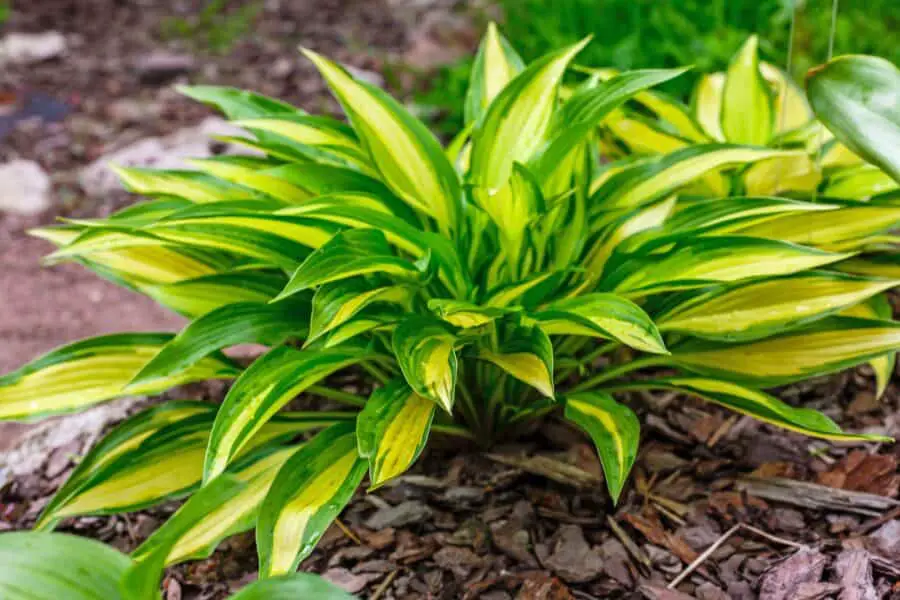
Small Hosta Varieties
Are you looking for the perfect small hosta varieties to grace your garden? With countless cultivars available, choosing the best ones for your space can be overwhelming.
To make this task easier, let’s explore some popular and stunning small hostas that fit well in shade and sun environments.
Small hostas that work well for shade to light shade environments:
Autumn Frost: The leaves emerge power blue with a bright yellow margin that lightens to creamy white in the summer. Typically, 12″ tall by 24″ wide.
Cherry Berry: Long narrow leaves dark green with yellow to white centers. 10-20″ tall by 15-20″ wide.
Color Festival: Dark green margins, white center with a bold yellow streak between. Typically, 15″ X 24″. A good grower can push this plant into the medium category.
Golden Tiara: Leaves green with a wide chartreuse margin that becomes green in the sun. Top of the small grade, 15″ by 24-30″ wide.
June Spirit: Shiny leaves, deep green margins with chartreuse centers. 12-15″ tall by 24-28″ wide.
Lakeside Paisley Print: Wavy green leaves with beautiful white to gold patterns. 10-12″ tall by 20-24″ wide.
Rainbow’s End: Shiny green leaves with bright yellow centers. 10-12″ tall by 20-24″ wide.
Rainforest Sunrise: Leaves emerge green and take on bright gold centers. 8-10″ tall by 18-24″ wide.
Stiletto: Rippled green leaves with a narrow white edge. 10-12″ tall by 24-30″ wide.
Sunset Grooves: Wide green edges with yellow centers. 10-12″ tall by 18-24″ wide.
White Feather: Emerges white and turns green in summer. 10-12″ tall by 16-24″ wide.
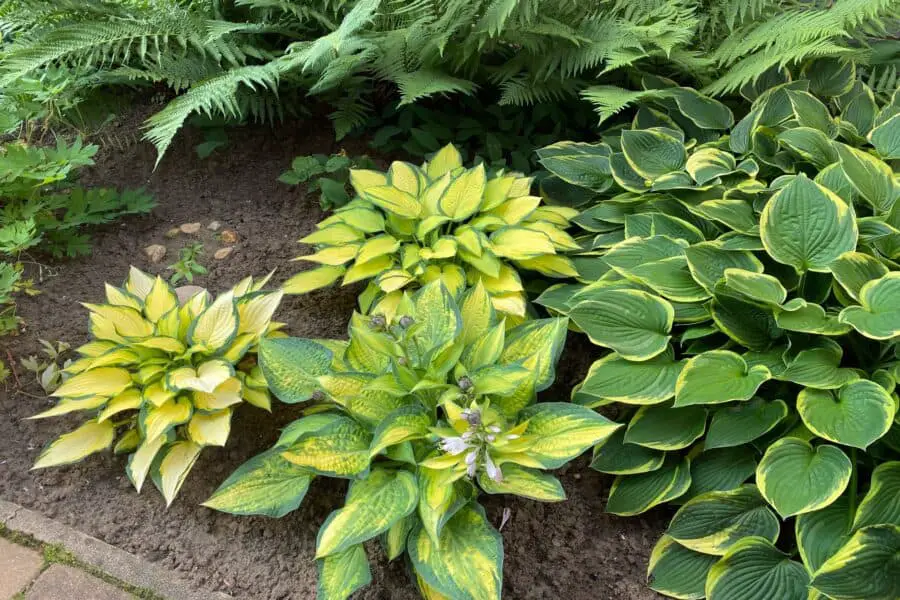
Small Hostas For Sun
While most hostas prefer shade, some small hostas can tolerate sunnier conditions. These sun-tolerant varieties can add a pop of color and texture to sun-soaked areas of your garden. Here are a few examples:
Hacksaw: Leaves are very narrow, rippled and serrated. 8-9″ tall and 20-24″ wide.
Hadspen Blue: Powdery blue leaves. 10-15″ tall by 20-24″ wide. A good grower can get this into the medium category. Excellent blue.
Little Sunspot: Matt gold leaves with green margins. Slug resistant. 10-12″ tall by 12-15″ wide.
Maui Buttercups: Yellow cup shaped leaves. About 10″ by 10-18″ wide. An excellent hosta.
By selecting these adaptable specimens, gardeners can create harmonious and inviting spaces that cater to both aesthetic appeal and the plants’ well-being.
A warning if you are new to growing hostas. The hot afternoon sun can burn just about any hosta. Please help them by positioning them where they will receive at least light or dappled afternoon shade.
Do Small Hostas Need Special Care
When growing small hostas, one must be aware of specific differences in care compared to larger hosta varieties.
While the overall maintenance for hostas is typically similar, specific guidelines will help ensure the health and success of your small hostas.
One aspect to consider is water requirements. Smaller hostas may need more frequent watering due to their smaller root systems. Furthermore, mulching can help retain moisture and suppress weed growth around your plants.
Again because of their small size, slug damage can be more unsightly than in larger hostas. Extensive loss of foliage can also set these plants back, especially with newly planted hostas.
Hostas of all sizes are tough and much easier to grow than many other garden plants.
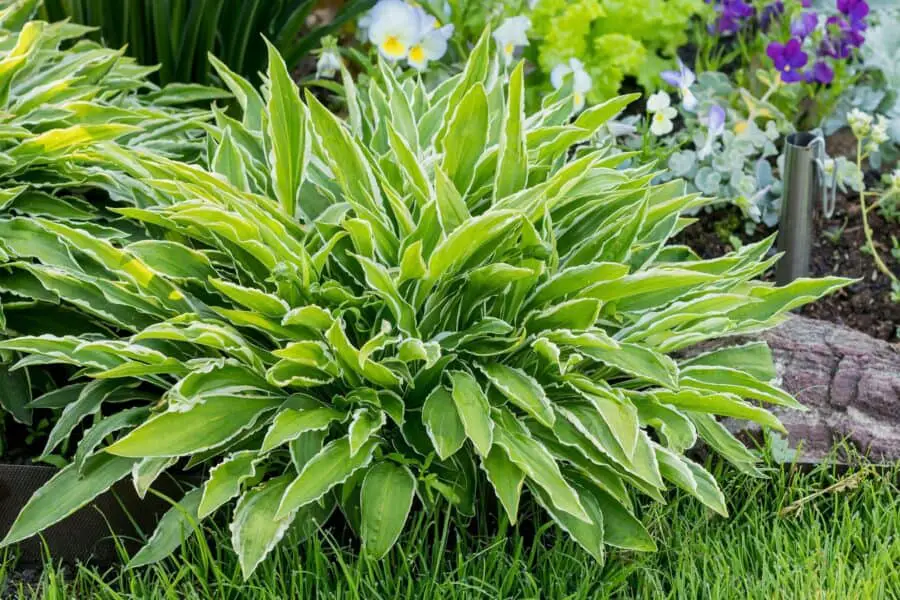
Design Ideas For Small Hostas
When planning a garden with small hostas, it is essential to consider several design principles that can enhance their visual appeal and overall impact on the landscape.
One of these principles is scale, which refers to the relationship between the size of the plants and their surroundings.
Small hostas work in various settings, from intimate courtyard gardens to larger landscapes where they may serve as groundcovers or accents, among other plantings.
Layering: Position small hostas in such a way that they create depth and visual interest by layering them with taller plants like ferns or grasses in the background.
Textural contrast: Combine small hostas with plants that have contrasting textures, such as rough bark or smooth foliage, to create an engaging sensory experience.
Color harmony: Select complementary colors for surrounding plants to accentuate the beauty of small hostas’ foliage and enhance the overall garden design.
Considering these design ideals when planning a garden can ensure that small hostas are showcased effectively and contribute positively to the beauty and functionality of outdoor spaces.
With these concepts in mind, it becomes apparent how versatile and valuable small hostas can be when incorporated into diverse garden designs.
Container Gardening With Small Hostas
Container gardening has become increasingly popular due to its versatility and adaptability, allowing gardeners to experiment with various plant combinations and create stunning displays.
Small hostas are an excellent choice for container gardening as they provide a lush, leafy display that is easily combined with other sizes of hostas or mixed plants.
When selecting containers for small hostas, it is essential to choose pots that provide adequate drainage and provide sufficient space for the root system to develop.
Additionally, selecting containers made from terracotta, wood, or hypertufa can help protect your planters from waterlogging, ensuring optimal growth conditions for these shade-loving perennials.
One advantage of using small hostas in container gardens is their ability to thrive in various environments, from shaded corners to brightening a patio or balcony.
Combining small hostas with companion plants with similar growing conditions allows gardeners to create visually appealing arrangements while promoting healthy plant growth.
Incorporating plants with contrasting colors, textures, and forms can add depth and interest to the overall design while encouraging beneficial insects and pollinators into the garden space.
As the season progresses and small hostas begin displaying their delicate flowers on slender stalks, their elegant charm will undoubtedly captivate all who encounter these delightful container gardens.
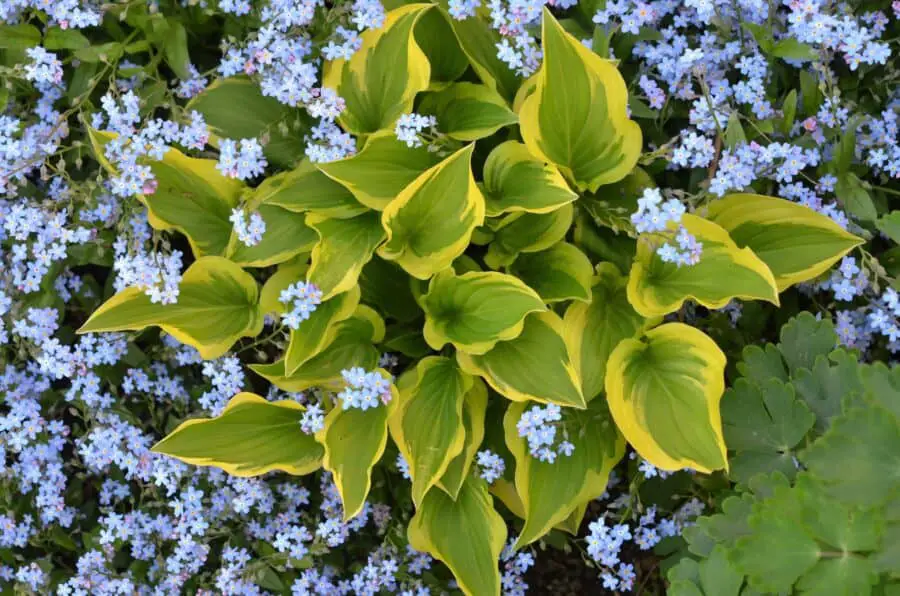
Companion Plants For Small Hostas
Just as the delicate brushstrokes of a skilled painter bring depth and harmony to a work of art, companion plants can enhance the beauty of small hostas in your garden.
The right combination of plants is akin to a symphony orchestra, with each component working together to create a masterpiece more remarkable than the sum of its parts.
To achieve this harmonious balance, consider incorporating these four types of companion plants into your garden design:
Ferns: With their feathery foliage and varying shades of green, ferns provide a contrasting texture to the bold leaves of small hostas.
Heucheras: Also known as coral bells, these low-growing perennials offer vibrant colors ranging from burgundy to lime green that can accentuate the subtle hues found in hosta leaves.
Astilbes: These shade-loving perennials produce fluffy plumes of flowers in shades from white to deep red, adding vertical interest and a touch of softness to your garden composition.
Pulmonarias: Their spotted foliage and charming bell-shaped flowers contribute eye-catching detail that complements the simple elegance of small hostas.
Many more garden plants, big and small, will pair well with small hostas.
The list above will get you started before you go your own way selecting companion plants for these jewels.
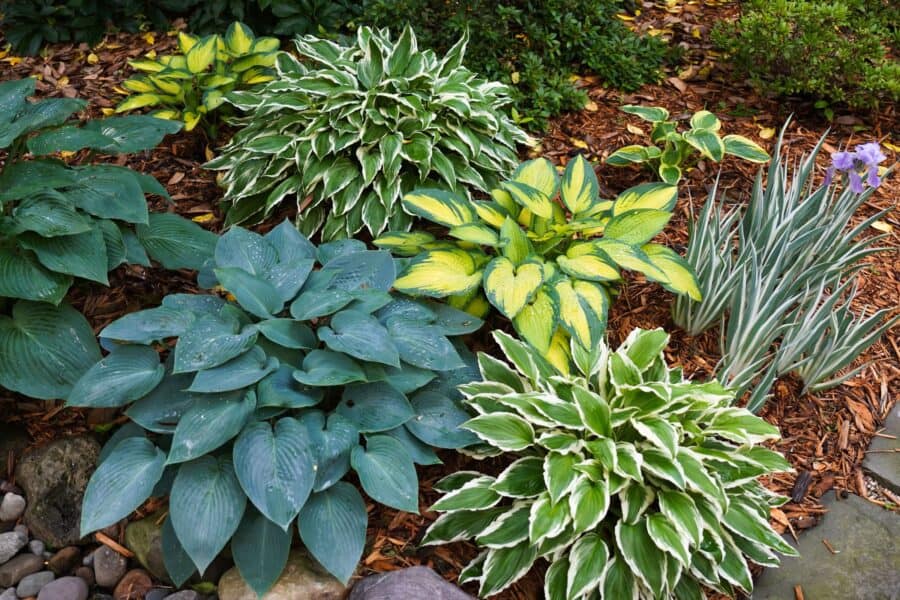
Landscaping With Small Hostas
Small hostas are versatile plants that work in various garden designs to create visually appealing landscapes.
They are ideal for creating contrast in texture and color, and their compact size allows them to fit into tight spaces, such as along walkways or in rock gardens.
Utilizing small hostas in groupings can add depth and interest to a landscape while serving as a low-maintenance ground cover.
When designing a garden with small hostas, it is essential to consider factors such as light requirements, soil conditions, and companion plants.
One effective way to utilize small hostas in the landscape is by grouping them according to similar characteristics or complementary colors.
Small hostas offer numerous landscaping possibilities due to their size and adaptability. Here are some ideas for incorporating small hostas into your landscape:
Border plantings: Use small hostas to create a low, dense border along pathways, garden beds, or the base of larger plants.
Rock gardens: Intersperse small hostas among rocks and boulders to add color and softness to an otherwise rocky landscape.
Accent plants: Plant small hostas near focal points such as statues, water features or in front of more extensive plantings to draw attention.
Avoid overcrowding small hostas, which can hinder their growth and minimize their ornamental value.
Instead, group them in clusters or arrange them with suitable companion plants to create an attractive and balanced garden setting.
Closing Thoughts
Throughout this article, you’ve learned about the increasing popularity of small hostas in gardens and various landscaping projects.
Whether planted in shady areas, exposed to sunlight, or even nestled in containers, small hostas can provide a charming and versatile addition to your garden.

